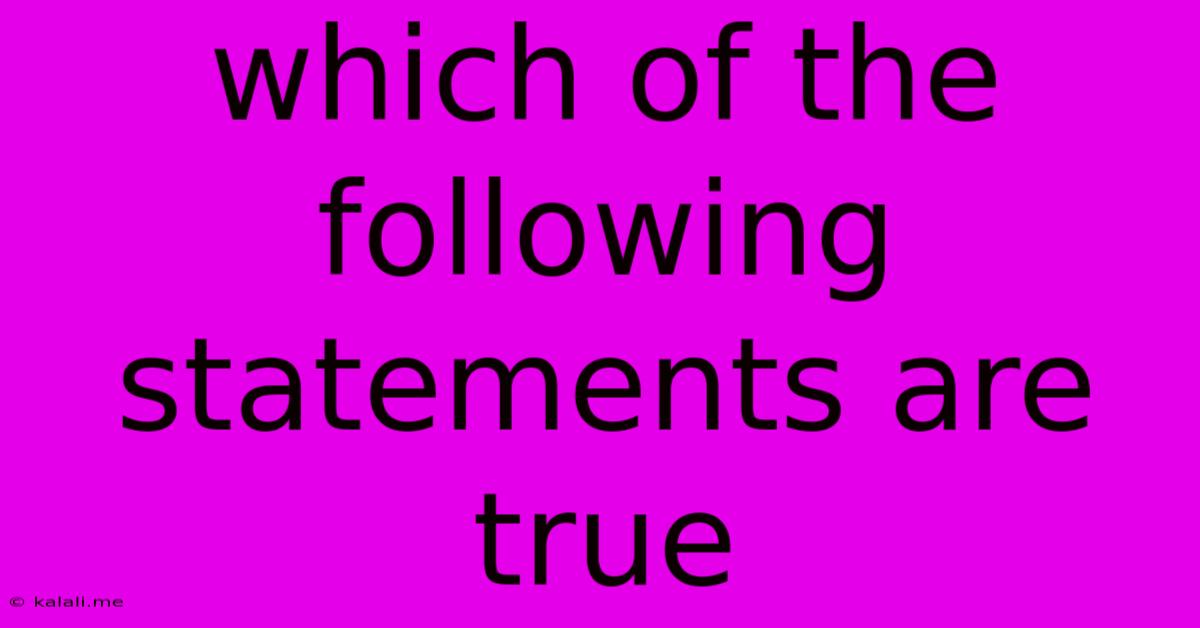Which Of The Following Statements Are True
Kalali
May 21, 2025 · 3 min read

Table of Contents
Determining Truth: A Guide to Evaluating Statements
This article explores the crucial skill of evaluating statements and determining their truthfulness. It's a skill vital in everyday life, from navigating news articles and social media to making informed decisions in personal and professional contexts. We'll examine strategies for identifying factual accuracy, recognizing biases, and understanding the nuances of language used to present information.
What Makes a Statement True?
A true statement accurately reflects reality. It aligns with verifiable evidence and doesn't contradict established facts or accepted knowledge. However, determining truth isn't always straightforward. Context, perspective, and the intention of the speaker all play a role. A statement might be true in one context but false in another.
Strategies for Evaluating Statements:
Several approaches help us assess the truthfulness of a statement:
1. Fact-Checking and Verification:
- Source Analysis: Identify the source of the statement. Is it a reputable organization, a known expert, or an anonymous online post? Consider the source's potential biases and motivations.
- Evidence Gathering: Search for corroborating evidence from multiple independent sources. Cross-referencing information is key to avoiding misinformation.
- Date and Time Sensitivity: Check if the information is up-to-date. Facts and figures can change over time.
- Primary vs. Secondary Sources: Favor primary sources (original documents, firsthand accounts) over secondary sources (interpretations or summaries of primary sources).
2. Identifying Logical Fallacies:
Logical fallacies are errors in reasoning that can make a statement seem true even if it isn't. Be wary of:
- Appeal to Authority: Accepting a claim solely because an authority figure said it, without considering other evidence.
- Straw Man Fallacy: Misrepresenting an opponent's argument to make it easier to attack.
- Bandwagon Fallacy: Accepting a claim because many people believe it.
- False Dilemma: Presenting only two options when more exist.
- Hasty Generalization: Drawing a broad conclusion based on limited evidence.
3. Recognizing Bias and Perspective:
- Hidden Agendas: Be aware that the presenter of a statement might have a personal, political, or financial interest in shaping your opinion.
- Loaded Language: Pay attention to emotionally charged words or phrases that might sway your judgment.
- Confirmation Bias: Be mindful of your own biases. We tend to favor information that confirms pre-existing beliefs.
4. Understanding Nuances of Language:
- Ambiguity: Clarify any unclear or vague statements. Ask for clarification if necessary.
- Implication vs. Explicit Statement: Distinguish between what is directly stated and what is implied.
- Contextual Understanding: Consider the surrounding information and the overall message being conveyed.
Applying These Strategies:
Let's consider a hypothetical example: "Eating chocolate every day is beneficial for health." To evaluate this statement, we'd:
- Fact-Check: Search for scientific studies on the health effects of daily chocolate consumption.
- Identify Potential Bias: The statement might come from a chocolate company with a vested interest in promoting chocolate consumption.
- Consider Nuances: The statement is vague. What type of chocolate? What quantity? What are the potential benefits and drawbacks?
By applying these strategies, we can determine that the statement is likely false or at best, an oversimplification. While moderate chocolate consumption might have some health benefits (due to antioxidants, for example), daily consumption in large quantities is unlikely to be universally beneficial.
Conclusion:
Determining the truthfulness of a statement requires critical thinking and a systematic approach. By employing fact-checking, identifying logical fallacies, recognizing biases, and understanding the subtleties of language, we can improve our ability to evaluate information accurately and make informed decisions based on sound judgment. This skill is essential for navigating the complexities of the modern information landscape and becoming a more informed and discerning individual.
Latest Posts
Latest Posts
-
White Spots On Rose Bush Leaves
May 21, 2025
-
Find Out If Someone Is Married
May 21, 2025
-
How To Remove Dried Tile Grout
May 21, 2025
-
How Many Degrees In A Full Turn
May 21, 2025
-
What Temperature Should Your Coolant Be
May 21, 2025
Related Post
Thank you for visiting our website which covers about Which Of The Following Statements Are True . We hope the information provided has been useful to you. Feel free to contact us if you have any questions or need further assistance. See you next time and don't miss to bookmark.